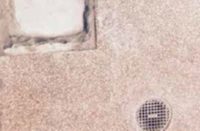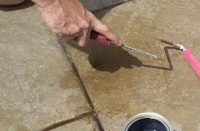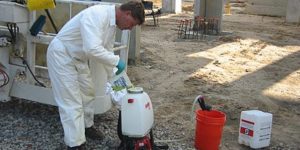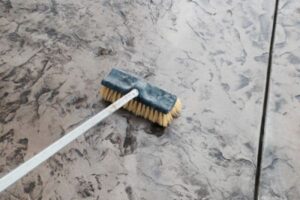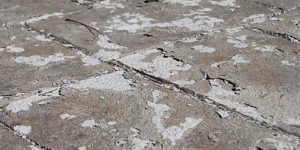Imagine the perfect concrete sealing day — 70 degrees, sunny and no rain for the next 10 days. You just finished sealing a beautiful concrete pool deck. The homeowner loves it, and it looks so good that the next-door neighbor has asked for a quote.
The homeowner pays you on the spot (which was a huge blessing as you really need that check to cover payroll tomorrow). So, you pack up, say goodbye and move on to the next job, with the possibility of being done for the day around 3-3:30. That’s what I call a stress-free day and I truly love them.
The next day is a different story. As the sealer dries and cures, the mistakes in the application process begin to show up. I call these issues “concrete sealer uglies,” situations where something doesn’t look right.
Homeowners will call the next day if there are any “sealer ugly” issues with the completed job, and they should. Don’t take it personally. Don’t argue with the homeowner. Just go fix it. When you circle back to fix the ugly sealing error, learn from it.
When it comes to sealing concrete, you need to remember one simple thing. Concrete sealer is a liquid coating that’s either rolled or sprayed onto a porous concrete surface.
As you apply the sealer, you must account for real-world variables like temperature, rain forecast, time of day, type of sealer being applied, type of concrete finish, employees, mowers, sprinklers, wind, leaves and homeowners.
All these variables can lead to an ugly sealing job. I had to learn about these application variables the hard way, but since have figured out how to minimize concrete sealer ugly problems. Then I had to train my staff to understand the concrete sealer uglies and how to avoid them.
Here are the most common concrete sealer uglies that we deal with regularly at Stephens Concrete Sealing.
Surface bubbles
Bubbles are caused by a heavy application of sealer or sealer that’s applied to a hot surface. When the sealer is applied too heavily, the air displaced can’t escape through the surface, and it forms bubbles in the sealer surface.
When it’s 95 degrees outside the concrete is 105 degrees. The outgassing from the concrete can’t escape because the sealer flashed off too fast.
Remedy? Apply the sealer early in the morning before the heat of the day or reschedule the work to a cooler day.
Blushing, haziness or cloudiness
A cloudy-looking surface is caused by sealing the concrete when the surface is wet or got wet before it fully dried. When this occurs, the sealer won’t bond to the concrete surface. Instead, it’ll trap the water between the surface and the sealer.
It’s easy to dry the surface before applying sealer. But a scattered rain shower or a timed sprinkler session can wet the sealer while it’s drying.
Remedy? Remind homeowners to turn off the sprinklers for the day and be mindful of impending rain.
White or powdery look
If the temperature during application is too low or the humidity is too high, the sealer’s carrier will evaporate either too fast or too slow. The sealer will dry white or powdery because the resin particles didn’t fuse together before drying.
Remedy? Always find out what temperature and humidity conditions manufacturers require for successful application of sealer.
Blotchy or darker in some areas
Topical film-forming acrylic sealers with a higher solids percentage will always darken concrete. Every slab is unique in its color and texture. The color of the concrete after the sealer is applied is difficult to predict.
The mix design, use of chemical admixtures, finishing techniques and porosity are just a few factors that will affect the concrete surface color. A film-forming sealer will deepen the true color of concrete and create a high gloss or wet look for decorative concrete.
If you apply these sealers to a broom finish, the sealer will bring out the “grain” in concrete just like a varnish does on wood and show all the concrete’s imperfections.
Remedy? Do a small sample to make sure the color change will be acceptable to the homeowner.
Endless other variables
Tire marks show because homeowners drove on the sealer too soon. They only waited four hours instead of 24 hours like you told them.
The mowers came and mowed the lawn after you finished and left. They somehow missed the bright pink tape you used to rope off the driveway for no access. They got grass clippings on the sealer.
Mother Nature came calling and blew leaves onto the sealer.
Your employees just didn’t do their job right. It was the last job of the day and they were lazy. They cut corners so they could cut out earlier.
Besides these, there are tons of other variables that can affect the outcome of the sealer.
When it comes to sealing concrete, don’t underestimate the value of the application. If an ugly pops up or a problem occurs after you’ve finished, take a deep breath and go fix it. If you try to be perfect on the application, you’ll overapply the product or overthink the process. And, if you try to wait for the perfect weather to seal, you’ll never finish your work.
When it comes to sealing concrete know your products, know your capabilities, know your equipment, know your employees’ abilities and keep an eye on the weather.
If you get in a jam and get a sealer ugly callback, roll with it. Everything is fixable. If you have a question, email me at the address below or call me. I’m glad to help.

